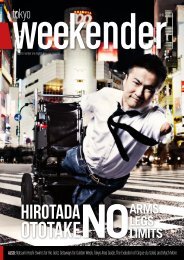Tokyo Weekender July 2016
Breaking the rules of kimono – a new book shatters antiquated views of this traditional garment. Plus: The boys for sale in Shinjuku Ni-chome, best sake of 2017, Japan's new emperor, and what really goes on inside "Terrace House."
Breaking the rules of kimono – a new book shatters antiquated views of this traditional garment. Plus: The boys for sale in Shinjuku Ni-chome, best sake of 2017, Japan's new emperor, and what really goes on inside "Terrace House."
Create successful ePaper yourself
Turn your PDF publications into a flip-book with our unique Google optimized e-Paper software.
THE MISUNDERSTOOD<br />
CROWS OF TOKYO<br />
Love or hate them, the city’s gigantic crows cannot be ignored. To make sense<br />
of their place in the concrete jungle, we look at their longheld connection with<br />
Japan, and some surprising lessons we can learn from these sometimes smart,<br />
sometimes foolish “urban guerrillas of birds”<br />
Words by Alec Jordan<br />
In Japan, the public perception of crows got off to a pretty<br />
good start: According to the Kojiki and the Nihonshoki, two<br />
of Japan’s oldest written records, a gigantic crow known as<br />
the Yatagarasu guided the mythical first emperor of Japan<br />
to the part of the country now known as Nara. This crow,<br />
which is often depicted with three legs, can be found at the Kumano<br />
shrines of Japan, and even more commonly, on the uniforms<br />
of the Samurai Blue – Japan’s national soccer team.<br />
But even though they have been common figures in art from<br />
well before the Edo period, crows are generally seen with a mixed<br />
perspective in Japan. On one hand, you have the traditional song<br />
“Yuyake Koyake,” which plays on loudspeakers every afternoon<br />
and whose lyrics tell us return home like the crows return to<br />
their roosts in the trees, but there are also still the associations<br />
of the birds with death – even today, there is a superstition that<br />
if a crow perches on a house at night and calls out, someone in<br />
that house will die before long. We may be happy to return home<br />
like crows – as straight as they fly – but we don’t necessarily want<br />
them roosting with us.<br />
Today, perhaps, the biggest problem that people face with<br />
crows around <strong>Tokyo</strong> is trying to keep them out of their garbage.<br />
And the birds can cause other kinds of trouble as well: the <strong>Tokyo</strong><br />
Metropolitan Government receives some 600 calls a year from<br />
<strong>Tokyo</strong>ites who’ve been attacked by crows – most often in spring,<br />
around the time when the birds are hatching their eggs and raising<br />
their newborn young.<br />
Nonetheless, crows have their fans in <strong>Tokyo</strong>, just as they do<br />
everywhere around the world. Why? It could be their intelligence<br />
– crows know how to use tools, they recognize human faces, and<br />
they’ve even been observed to hold what look to be funerals. It<br />
might be their distinctive voices: crows and their larger cousin<br />
the ravens are believed to possess some of the most complicated<br />
vocabulary of calls of any bird. Or maybe it’s a shared sense<br />
of play. The birds have been seen using wind currents like children<br />
might use waterslides, throwing paper to themselves, going
















